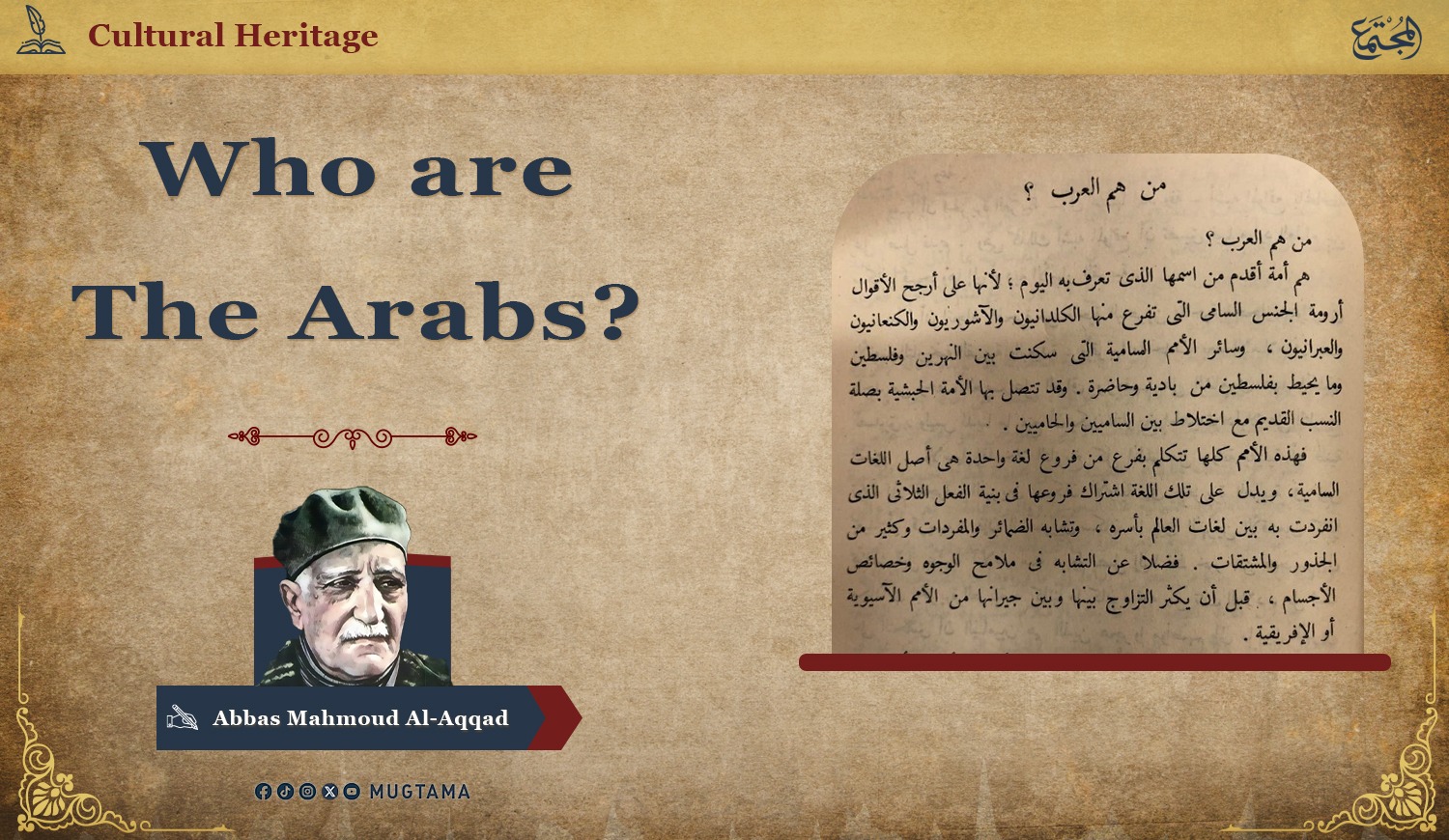Who are the Arabs?

They are a nation older than the very name by which they are known today — for, according to the most reliable accounts, they are the original root of the Semitic race, from which branched the Chaldeans, the Assyrians, the Canaanites, the Hebrews, and all the other Semitic peoples who inhabited the regions between the two rivers (the Tigris and Euphrates), Palestine, and the surrounding deserts and cities. The Abyssinian (Ethiopian) nation may also be connected to them through an ancient lineage that included a mixture between Semites and Hamites.
All these nations spoke branches of one
parent language — the source of all Semitic languages. This is evident in their
shared structure of the triliteral root, which is unique among the world’s
languages, as well as in their similarity in pronouns, vocabulary, and many
roots and derivatives. This is in addition to the resemblance in facial
features and body characteristics before extensive intermarriage occurred
between them and their neighboring Asian and African peoples.
The Cradle of the
Semitic Peoples
If all these nations share one origin, then
the most likely and reasonable assumption is that this origin lies in the
Arabian Peninsula — and this for many reasons:
Among them is that the transition from a
nomadic, pastoral life to a settled life of cultivation, agriculture, and urban
dwelling is a familiar stage in human history. However, the reverse — that
people would move from city life and fertile lands to become wandering desert
nomads — is not a familiar pattern in history.
Also, the Arabian Peninsula, due to its
natural isolation, is one of the most likely regions to have preserved an ancient origin. At the same time, it
is also one of the most likely to have compelled its inhabitants to migrate,
due to its limited food resources, toward the fertile valleys of nearby rivers.
Moreover, the direction of migration from
the regions of Bahrain and Hijaz has been consistent throughout both ancient
and recent times. The most evident example is what occurred after the advent of
Islam, when the Arabs marched simultaneously toward Iraq and the Levant during
the caliphate of Abu Bakr al-Siddiq. Nothing prevents us from considering
modern historical movements as evidence for ancient ones — especially when
there are no historical accounts, certain or speculative, suggesting that the
inhabitants of Mesopotamia or the river valleys migrated into the Arabian
Peninsula. The Sumerians, the earliest known inhabitants of Mesopotamia, had
lived there ten thousand years ago, and there has never been any report of
their migration into any part of Arabia. On the contrary, it has been firmly
established that it was the Semites who migrated from their homelands into
Mesopotamia, where they founded cities bearing Semitic names, such as Babylon —
“Bab-Il” or “Gate of Allah.”
Challenging
Alternative Theories
As for the other opinion — that the Semitic
nations originated outside the Arabian Peninsula — the most prominent
proponent of this view was Professor Guidi, the renowned Italian scholar in
Cairo. His strongest argument rests upon the comparison of Semitic languages
and the abundance of words related to plants and water in their earliest forms.
He believed that the shared vocabulary among Semitic tongues indicated that
they must have originated in fertile lands rich in vegetation and rivers,
rather than in the barren deserts of Arabia.
However, this view is weak and unsupported
by solid evidence, and it also contradicts what is known of Arabia’s condition
long before modern explorations, as well as what recent geological, climatic,
and anthropological studies have revealed.
The fertile meadows and lush lands were
never entirely absent from southern Arabia, nor from its northeastern regions
around Bahrain and Wadi al-Yamamah — areas through which migrants had passed
since ancient times, sometimes traveling from Yemen to Bahrain and then to
Mesopotamia and the Syrian Desert, and sometimes from Bahrain northward.
Even after the rise of Islam, the lands of
Yamamah remained known for their wide pastures, abundant springs, heavy
rainfall, and verdant meadows — remnants of an even more fertile and populated
past. The German explorer Schweinfurth noted that wheat, barley, buffalo,
goats, sheep, and cattle were found in their natural, undomesticated forms in
Yemen and ancient Arabia before they appeared in domesticated forms in Egypt
and Iraq. Recent scientific discoveries have shown that the Arabian Peninsula
has experienced cycles of drought and seismic activity since ancient times —
long before recorded history — during which barren lands gradually replaced
fertile regions.
Thus, the condition of Arabia itself is
sufficient to explain the linguistic similarity among the Semitic peoples in
words related to fertility, vegetation, and water. The opposing theory, however
— that of Professor Guidi — fails to explain the notion of a supposed migration
of Arabs from Mesopotamia or the Levant into the Arabian deserts. This
assumption has no historical basis, neither in ancient accounts nor in any
logical or natural patterns observed in human settlement, as proven by
historical examples.
The Arabs’ Lasting
Contribution to Civilization
Therefore, it is valid to consider that the
lineage of the Arabs, born in their original peninsula, had inhabited the
central regions of the civilized world for at least five thousand years.
Everything that Europeans later acquired from these lands throughout history
was either purely Arab heritage or knowledge that spread through the Arab
peoples after their interaction and intermarriage with the natives of those
lands.
And this heritage is no small matter — for
it encompasses the oldest roots of everything that Europeans consider
foundational in the realms of intellect, spirit, civilization, and progress.
These include:
(1) the heavenly religions,
(2) the ethics and principles of life and conduct,
(3) the arts of writing and education, and
(4) the crafts of peace and war, and the exchange of goods and produce.
-------------------------------------------------------------
Resource: Book “The Impact of the Arabs on
European Civilization” by Abbas Mahmoud Al-Aqqad
Read also:
-
Book Review “The Impact of the Arabs on European Civilization”










